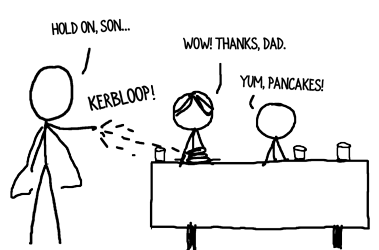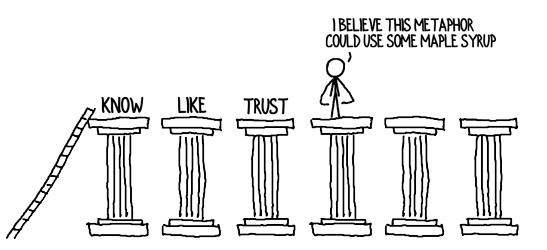If You Master This One, Consulting Super Power, More Businesses Will Seek Your Help
If you could have any super power, what would it be? People typically want the power to fly, or x-ray vision, or the ability to spray maple syrup from their fingertips. As a consultant, though, you want to don a cape, strike a superhero pose and proclaim in your deepest voice, “I am the Amazing TrustMaster!”

Trust, more than any of the other Six Pillars of Consulting Success, determines which consultant a client will choose for their project. That’s why I write and teach extensively about the three components of Trust and how to build trust with individuals. But there’s more to this super power than winning individual projects.
When you move beyond Trust-building with individuals to Reputation-building at the organizational level, multiple buyers across the company will consider you the first consultant they should call. You’ll receive inquiries from decision-makers you may have never even met. How cool is that?
Similar to people scanning a product’s user reviews on Amazon.com before making a purchase, executives listen carefully to internal reviews of a consultant. Your reputation inside the company dictates your ability to branch out into additional divisions, functions, geographies, etc.
To build a five-star reputation inside a client, focus on two elements: Credibility and, more importantly, Customer Experience.

The three techniques below will increase your Credibility across the enterprise.
Building Credibility at the Enterprise Level
1. Seek Internal Endorsements
Some clients won’t allow you to use their name or company in a testimonial; however, that’s rarely a problem if the testimonial is used inside the organization. Use case studies, scorecards and results from your projects to generate internal buzz about the outcomes of your projects.
2. Maximize Long-Term Value
When consultants think about one decision-maker they typically strive to maximize the value for that client in the short term. At the enterprise level you have to consider how each project fits into your overall plan to maximize Total Captured Customer Value. That requires a more patient, high-level viewpoint. When you counsel, “I’d love to do this project for you, but let me show you why it’s not in your long-term best interests…” you demonstrate your dedication to the organization and build a reputation that transcends any individual.
3. Outlive Your Projects
Even after your individual projects end, continue to build your reputation as a thought leader and regularly contribute helpful articles, references and tools. There are many, ongoing opportunities to increase credibility, including sharing insights and introducing valuable contacts.

In terms of Customer/Client Experience, the following nine practices will help you become the fabled, Enterprise TrustMaster!
Improving Customer Experience at the Enterprise Level
1. Do Good Work
This almost goes without saying. At the organizational level you may be overseeing many projects. It’s your responsibility to stay on top of project quality, manage client expectations and ensure every engagement creates customer delight.
2. Be Prompt and Responsive
Clients take note of rapid turnaround and prompt, professional follow-up after meetings. They take note and they talk about it.
3. Be Easy to Do Business With
Beyond your day-to-day interactions, is working with your firm a breeze? Signs include: quick, painless negotiations; easy access to client portals and data; contact information is readily available; expense reports are detailed and accurate.
4. Polish Your Touchpoints
Why leave your client’s experience to chance? Think through your key touchpoints and write down your protocols. You should have a “pre-flight” checklist for every encounter with a client, from initial meetings to proposal follow-ups to meeting summaries to periodic project updates. Every interaction matters, and no matter what is happening in your world, you should come across as positive and enthusiastic when you talk to a client.
5. Create a Relationship Action Plan
If you want to work across an organization, you have to think, plan and act across the organization. The first step is mapping out the key individuals and creating a plan for meeting them and building relationships.
6. Always Look Professional
Invest in top-notch materials. Like it or not, the quality of your cards and stationery make a statement about your firm. Similarly, the design of your deliverables and even the quality of your presentation templates influence the client’s experience.
7. Repair Harm Immediately
Nobody expects you or your team to be perfect, but how you handle errors and gaffes is a critical part of the customer experience.
8. Create Opportunities to Add Value
Focus on soft benefits to the client like prestige, status, or quality of life. Something as simple as noticing your client is mailing a personal letter and saying, “I’m running by the post office, would you like me to mail that for you?” adds value and makes the customer experience positive.
9. Engage the Customer in Their Own Experience
Every project benefits from at least one, in-person work session. In addition, ask the client to touch base with you regularly, or to fill out a periodic project health assessment.
When you dust off your metaphorical cape and become a Trustworthy superhero, you’ll find more and more clients dialing your hot-line.
I’ve offered twelve practices that will power up your organization-wide Trust-building abilities. Help make it a baker’s dozen by offering another best practice below.
*This article is Part 4 of a seven-part series in which I show you how to win more follow-on and pull-through business by mastering the Six Pillars of Consulting Success at the “enterprise” level.

Part 3 – Adopt These 5 Practices. Clients Will Want to Call You.
Part 5 – Will Clients Need You Over and Over Again? Yes, If…
Text and images are © 2024 David A. Fields, all rights reserved.

 David A. Fields Consulting Group
David A. Fields Consulting Group 

I cannot help with the baker’s dozen at the moment, but do have something to add to these great points David. When I realized that it was important for my clients to trust me TO HELP THEM ACHIEVE RESULTS, in addition to basic human relationship trust, my practice got better. And my clients got better results.
Thanks! Lisa
That is exactly right, Lisa. As you know, one of the three points on the Triangle of Trust is: “You’ll help me.” Thanks for bringing that to the fore.
I blew it the other day with trust.
Usually people start trusting me when they witness my expertise for themselves. I step them through a decision-making process about which accounting software to use, or upgrade to, or whether a transition is needed at all. Or I share a QuickBooks technique that they didn’t know about which fixes the problem they called me about (which opens the way for them to ask me about more complex problems.) They like that I’m really smart, they need me to be really smart, and they pay be to be really smart on their behalf and to make things easier, faster, and more clear when it comes to accounting & finance.
But while I was on the phone with a prospective client the other day discussing the project she wanted, it was too much for her. She kept saying, “I don’t know about things like this, I’m not a CPA” and related comments, and although I got the message that she needed more relatedness, no jargon, more clarity, I wasn’t able to adapt my language enough. She let herself get overwhelmed and I was not successful in building the trust needed to prevent that.
By the conclusion of the call, I felt completely clear about what she needed and didn’t need for her accounting software conversion project, and she felt stupid.
NOT a good call.
Jaime, thank you for sharing this painful example. Your courage and dedication to helping the community are admirable. Language is important at the individual level (as you showed in your example) and at the enterprise level. When your terminology is in sync with the organization’s internal vernacular, you are viewed as a member of the family and Trust builds quickly.
In the example you gave, there’s the possibility you could not escape your consultingese. The prospect asked for a hot, easy-to-eat meal and you, being savvy, suggested a consommé. She says, “Huh?” and you attempt to use more common terminology by offering a bisque. She’s thinking “soup” and that’s where you need to be too. The easiest way to find that place is to listen and use the prospect’s exact language.
There’s another possibility though: the prospect may be insecure and become overwhelmed at the drop of a peanut. That’s not your fault. The path to Trust in that case is dropping the content entirely and attending to the prospect’s emotional needs. There’s truth in the bromide, “People won’t care how much you know until they know how much you care.”